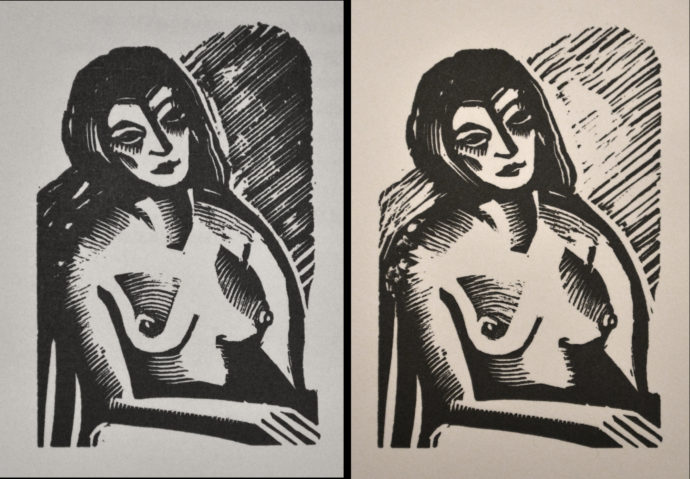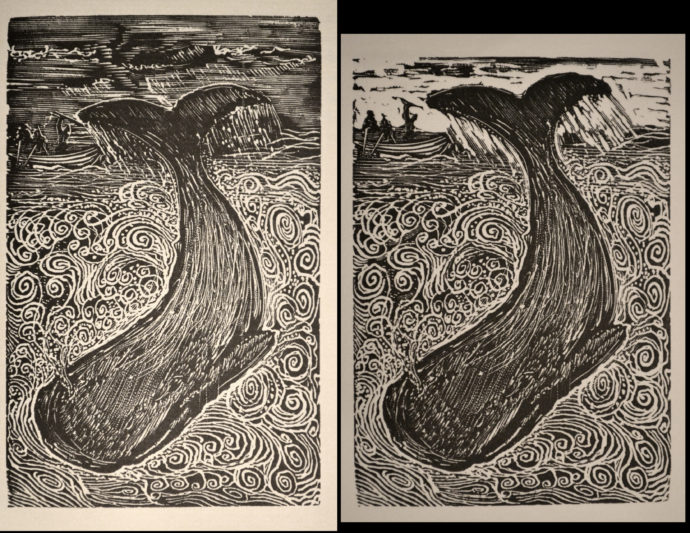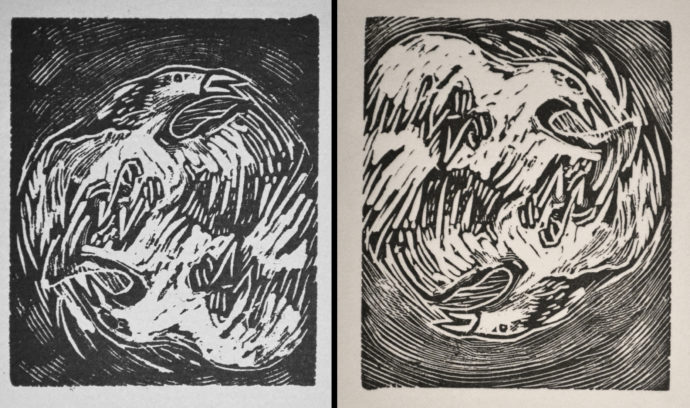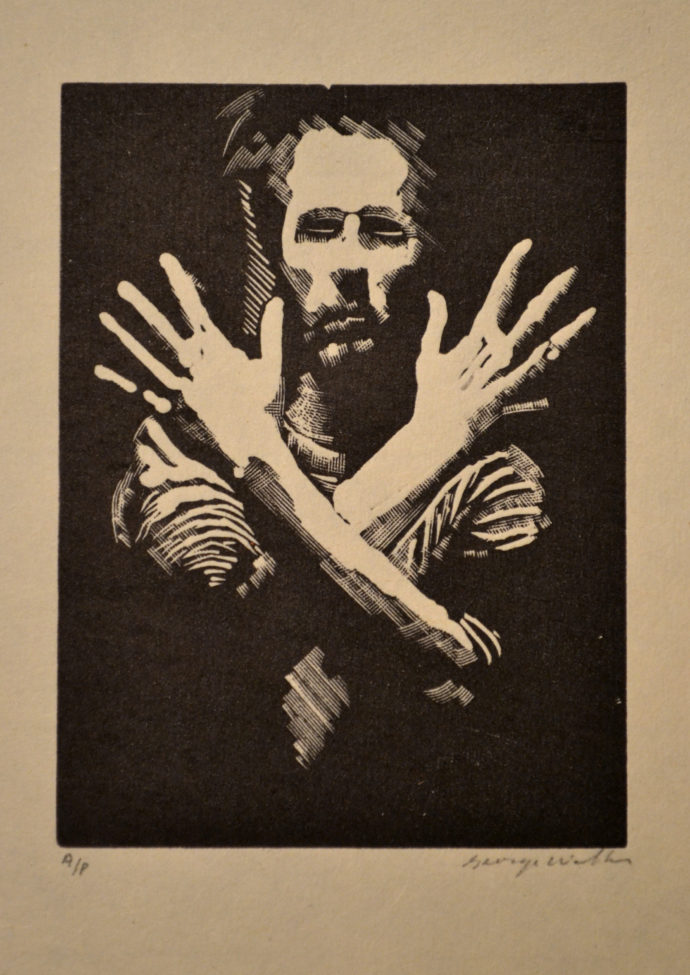Walker’s NEW NEO IS HERE
INTRODUCTION
George Walker’s new edition of Images from the Neocerebellum is a wonder indeed. Of course its presentation clamshell box is exquisite. One expects that in a Walker limited edition wordless book. The book itself with its beveled boards and black moiré cloth has heft and presence. And the personage with crossed arms stares at you from the box cover, the book cover as well as the title page.

George A. Walker, Images from the Neocerebellum, 2016, George Walker Books, Toronto, Canada, #2 from edition of 28, with clamshell box right. (All images courtesy of the artist.)

Lenticular version of “Big Hands,” signed, with black matboard.
And when you first lift the book from the case, a surprise greets you. A lenticular (ridged plastic ) version of his “Big Hands” wood engraving. So tempting to pick it up and slowing turn it from side to side so you can see the bigger hand become the left hand, then the right. (See a short video of it at the end of this post.)
But the real treat is inside Neocerebellum: page after page of some of George’s most powerful wood engravings. Each was inspired by a dream he had. He called it a dream diary. When Images from the Neocerebellum first appeared in 2007 as a paperback (The Porcupine’s Quill, Erin, Ontario, Canada), across from each image was a title and brief text description of the dream illustrated. In the new publication no text appears. Walker will explain his decision to eliminate text in the interview that follows.
Why George Walker decided to publish a limited edition–what I call his New Neo–was explained in a previous ART I SEE post. (See http://www.scottponemone.com/george-walkers-neo-neocerebellum/ It’s worth checking this out if only to see photos of the work in progress.) In short, George agreed with me that his Neocerebellum images deserved hand printing on his Vandercook proofing press. I made the suggestion in 2015 when he was in the midst of producing his Trudeau: La Vie en Rose wordless biography of Pierre Elliott Trudeau. He then gave his wife, Michelle, the task of finding the blocks for Neocerebellum. Some blocks stayed stubbornly missing. A few blocks were damaged. But last summer he set about to publish New Neo, deciding which images merited recutting because they were either missing or deemed not so well cut. He also needed to determine whether and where to trim the damaged blocks. In a few cases George chose to add wholly new images.
INTERVIEW
After the limited edition of Images from the Neocerebellum arrived in early December and after comparing the new version against the old one, I sent George my usual cascade of questions. He graciously replied just before New Years.

George Walker working on his limited edition of Neocerebellum. (Michelle Walker photo)
It’s odd that I need to reference the original book with its titles for each image in order to ask you about changes you have made.
Yes, I suppose it is odd to need one book to interpret the other, but what I was trying to do in the limited was to create a new experience. I thought the images should stand on their own without the explanations I provided in the popular edition. I printed 28 copies (half my age) because this edition was nostalgia for past dreams and a reflection on whom I have become. Some dreams were a transparency on my unconscious self and others (even now) remain opaque.
Essentially you kept the same sequence as in the original when I guess you were free to choose a completely new arrangement. Why so?
When the first edition of Neocerebellum came about in 2007, I spent a lot of time sorting my dream diary images into a chronology that I thought made sense. At the time I was thinking about Jung and Freud and dream interpretation. The task I faced was a perceptual “identifying” of sensory patterns, complexities of the dream images made into single frames. When we dream and then recall that dream later, the rationality of the daytime experiences before the dream filter gives the censoring force another form of meaning. Freud called this “secondary revision” when the mind attempts to sort the dream-sequence by giving it a narrative sense and coherence. The dream interpretation severs the pieces that have been artfully joined in the mind. The arrangement is more of a chronology, but this fails slightly because some of the images are based on recurring dreams.

“Meeting My Subconscious” (left) and “Hand Smoke.” (All plates © George Walker)
I see you left out “Meeting My Subconscious.” It seems a perfect topic for this book. But you leave it out. Why?
That was such a prophetic dream. It still haunts me. I searched my studio to find the original block—and I should have recut a replacement for the lost one—but I didn’t. This dream was two years before the birth of my granddaughter. I now think it foreshadowed her arrival. The text reads, “Waking up, I sit at the edge of the bed and am feeling distressed that I can’t remember my dream. As I puzzle over this, the room begins to move and a little girl runs from the dark and places her hand on mine. I try to look at her, but she became only a shadow. A fear runs through me as I realize I am still dreaming.”
What about dropping “Hand Smoke”?
Michelle had spent many hours in the studio looking for the blocks used in the Neocerebellum. She found most of them, but some remain lost, and I was left with the problem of what to do. I could recut—and some blocks I did just that. The other option was to replace them.

I like the new Bear image. Have you been face-to-face with a black bear?
I’ve encountered bears on my hikes and camping adventures, but I have never faced-off with a bear and I certainly wouldn’t want to. I used a similar image for the cover of Sue Goyette’s book, The Brief Reincarnation of a Girl published by Gaspereau Press (2015). In the book the bear appears as a symbol of hope and is the grounding force of the little girl’s fears and hopes.
In my dream of the bear, I am followed and then confronted by the bear as it emerges from the woods. Bears can be unpredictable, and its appearance in my dream made me wake up immediately. The psychologist Carl Jung believed that all wild animals in dreams represent feelings and emotions. I was profoundly affected after reading Goyette’s book and trying to find an image that fit her narrative. After the dream I knew exactly what the image would look like.

The first version of “Steppenworlf” (left), the recut version (right).
It appears you recut “Steppenwolf.” Tell me why, please.
In Herman Hesse’s book Steppenwolf the protagonist is ill-suited for a world filled with the everyday of frivolous bourgeois society. He is a stranger to his own society and outsider of two souls. I lost the original block and I felt this dream was significant enough for me to recut. I identified with the transformation imagery that I had in the original dream—myself as both man and animal.

Original (Left) and partially recut versions of “Night Jasmine.”
I see partial recutting of “Night Jasmine.”
When I started to pull proofs of the blocks to ready them for printing, I noticed that some parts of “Night Jasmine” were damaged, and I decided to recut some of the lines to fix them.

(L to R) “Dancer,’ “Crow with Rose” and “The Blackbird, Girl and Fish.”
Very nice new images after “Night Jasmine.” I know you’re not putting into words your dreams in new Neo, but can you tell me a little about them?
Thank you! The new images explore new haunts that I am puzzling over.
The image after “Night Jasmine” is a dancer who has just stopped moving and is resting between performances. I am sitting close by, but the dancer does not notice me. I can see the choreography in her mind and know exactly what she will spring into next. But I am not able to speak to her.
“Crow with Rose”–There is a landscape that is flat and wide open with the hot summer sun beating down. Three trees stand in the distance. I hear the distant caw of crows, and then one appears with a rose clutched in it’s beak. The rose falls from the crow’s grasp and lands near me; the crow fades into the horizon.
“The Black bird, Girl and Fish”–I am on a street and a girl is talking to a fish. The fish seems to understand her and she it. The language they are speaking makes no sense to me. A black bird flies over them, and their words become visible patterns in the air. I think I may be able to read them, but they are squiggles and lines that fade like vapor as the air from bird’s wings blows the whole dialogue away.

“Algonquin Park” before (right) and after trimming (right)

“Closed Eyes” before (left) and after trimming (right)
Why did you trim “Algonquin Park” and “Closed Eyes”?
The blocks were damaged and had crushed edges that I could only repair by cutting away the damaged parts. I find it interesting though how things change with time even if we leave them to their own fates. Just like these revisited dreams are not exactly the same as when I first made them.

“Momento Mori” was cut new for New Neo.
After “Closed Eyes” I see a number of changes like the reintroduction of “Evergreen Harvest.” The one new image that catches my eye is just before “Sleeping.” I love the skull on the right margin. What’s the story behind that?
I titled this one “Momento Mori” which literally means “remember to die” [in essence: “remember you must die”]. I was working on a book, The Facts in the Case of M. Valdemar by Edgar Allan Poe. The story is about a group of mesmerism doctors who decide to mesmerize a man on the cusp of death. The experiment works, but the man is trapped between the two worlds. The horror of this predicament kept me up at night. I imagined death was pulling at me and I was trapped.

“Timmy the Pierced Face Wonder” before (left) and after trimming (right)
I’m not to sure about the trimming of “Timmy the Pierced Face Wonder.” The original taller brow gave the head a shape to mimic of open mouth. Comments?
I agree. I was torn about how to deal with the damaged block. Perhaps I should have just printed it with the damage instead of trimming it down. But what’s done is done.

Original “Whaler” (left) and in New Neo (right)
Congrats on opening up and trimming the top of “Whaler.” It enhanced the narrative. Comment?
A happy accident really! I was preparing the block to print and was trying to fix the damaged top portion. Sometimes things just work out for the better.

The jester after “Whaler” seems to come from a different source. Was this image borrowed from another project?
I had this dream about the images on a Tarot deck coming alive. I thought the jester was symbolic of the mercurial man, clown and entertainer. I was working on my Leonard Cohen book at the time, and I thought perhaps he was the embodiment of this card. Then I changed my mind and didn’t use it in the final book.
If so, were any other new images borrowed?
Yes, “Momento Mori” is from The Facts in the Case of M. Valdemar by Edgar Allan Poe. But the process of “borrowing” is not as straight forward as taking from one thing and using it elsewhere. Sometimes I will engrave a dream image and then find a purpose for it in another project.

“Sleeping” and “Woman in Conversation”
[In fact George reused “Sleeping” and “Woman in Conversation”–both of which appeared in the original 2007 Neocerebellum (and reappeared in the new version)–in his first limited-edition wordless narrative Book of Hours, 2010.]

“Birds of a Feather” before (left) and after trimming (right)
I like the recutting of “Birds of a Feather.” But I’m not sure which version of “In Praise of a Lunar Phase” I like better. Your thoughts?
When I first made the image “Birds of a Feather” I intended to print it as a two-color block. The image that was printed in the first edition of “Neocerebellum” was the yellow colour block for the background. What you see in this new edition is the black key block that should have been used in the first edition.

“In Praise of a Lunar Phase” before (left) and after trimming (right)
The block “In Praise of a Lunar Phase” was modified to show movement. It was one of those experiments that I wanted to try but should have thought better of.

“Tow-headed Man” before (left) and after trimming (right)
I miss “Flying Dream” in the new edition. Did you not like it, or was it missing?
It’s a lost dream! I’m still looking for it.
I like the new version of “From the Building,” while I don’t think you improved “Two-headed Man.” Just my opinion.
Sometimes I fail and sometimes I get it right. Sometimes I don’t know until I leave it alone and wait a few days. Jack Kerouac famously said, “My fault, my failure, is not in the passions I have, but in my lack of control of them.”
That’s probably too much, but I am curious as to what went through your mind when you worked on this project.
I revised my text introduction to this dream diary. I went back to reread some texts on dream theory and rethink the meanings of the signs and symbols that inform our unconscious mind. Like Jung’s experimental exploration of the unconscious, I wanted to confront my dreams through willful engagement and conscious revisiting of what Jung termed “mythopoetic imagination.”
Did your thoughts about dream imagery change?
I would say my thoughts about dreams are changing but only insofar as I am still torn about the conscious and unconscious communication between states. The questions I have–on how much of one state of mind informs the other and are they equal in their effect on our behavior–still engages my curiosity.
Was your appreciation of your earlier block cutting generally enhanced by redoing Neo?
No, I sometimes grow to dislike my previous work. I wanted to consider again why I did the piece in the first place, especially with the possibility of changing the order and deleting dreams I did not like. Revisiting my blocks disrupts my ego and makes me consider what the purpose of the project was and why I would expose my unconscious self to the scrutiny and critiques of others. It’s good therapy!

Upon my request, George and I swapped wood engravings. My choice was a proof of the cover image, what I call “Man with Crossed Arms.”
What type of comments have you gotten on new Neo?
One comment was: “What a beautiful book—but George—your dreams are creepy!”
“Purely personal associations with dream imagery are less important than the archetypal associations shared as part of our cultural consciousness. That is, perhaps, part of what makes Images from the Neocerebellum so fascinating: the blending of sensations that seem uncannily familiar with imagery that is uniquely the artist’s own.” —Katherine R. Lieber
“We are all bothered by items from our subconscious, be they thoughts, desires or even actions that we question later. Dreams are a big part of our subconscious. And if we choose to think about our dreams or even talk about them, we find that we are finding truths about ourselves. But do our words–written or spoken–do enough to explain our dreams or does a visual record need to be done to describe the images we see in our sleep. That is the type of thought one gets when one looks at George A. Walker’s Images from the Neocerebellum.” — Steven Buechler
Did doing this change your thoughts about future projects?
Every project makes me consider my choice of materials, typography, design and structure. I ask myself: Did the concept communicate effectively? Was the work well crafted? Did the work have a narrative flow or was it disruptive?
ADDENDUM
When writing the introduction to this post, I didn’t know how to describe the bonus lenticular version of “Big Hands” that came with the book. So I asked George what it was and added:
What inspired you to add it? What a treat to find in the box. I hope all purchaser of your New Neo get to have one.
It’s a lenticular of one of my engravings. It’s made by using software to interlace the images and then attach a lens to create the effect. It can either be used to create an animation or 3D effect. Here’s the Wiki with the details: https://en.wikipedia.org/wiki/Lenticular_printing
I thought a lenticular would work well as a dream image because of the magical properties in the way the lens tricks our eyes into seeing motion or depth. The image I chose was based on a dream I had where my hands grew large and then shrunk down. I thought a dream about transformation would work well with a lenticular flip image (animation). I included one of two images in each book. You can see the other image here:
Bottom of the page: http://www.george-walker.com/Neocerebellum_web/Neocerebellum.html
I used an animated gif to imitate the effect of the lenticular.
[Here’s a clumsy video of mine to show the “Big Hands” lenticular animation.]
LINKS
Here’s a link on George Walker’s website to a flip page version of the original book: http://www.george-walker.com/Neo_Page_Flip/neo2.html
And here’s a YouTube video on the original Neo: https://www.youtube.com/watch?v=VOedzo9YJj0
For those considering obtaining their own copy of the limited edition of Neo, please go to: http://www.george-walker.com/Neocerebellum_web/Neocerebellum.html
Trackback URL: https://www.scottponemone.com/walkers-new-neo-is-here/trackback/










